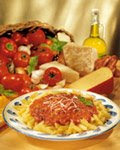Sunday, May 21, 2006
Some Interesting Notes About Asian Cooking
Among the Asian recipes, curries are very popular. South Western regions (India, Parkistan and Sri Lanka) curries are generally based on yogurt, whereas the curries of the South East regions (Thailand, Laos, Cambodia, Vietnam, Indonesia ,Malaysia, Singapore, Brunei) and North East regions (China, Korea, Japan ) are generally based on coconut milk.
Rice is a staple starch in all three cuisines regions. In addition to rice, South Western cuisines include a variety of breads and South East and North East cuisines include rice and egg noodles.
In the South West, the major oil used in frying is ghee, or clarified butter. In the South East and North East areas, the major oils are vegetable oils.
Garlic, chili and ginger are used in all three cuisine areas although chilies are much more common in the South Westand South East. The North Eastern cuisines use soy sauce in nearly everything; the South East substitutes fish sauce; there is no equivalent in South Western cooking. In the South East, there are two additional flavorings that are not used in the other cuisines - galangal and lemon grass.
Rice is the staple grain of the North East and South East and is only slightly less important in the South West. It is the original crop that caused the conversion from hunter-gatherer to subsistence farmer In this area; as such it spread across the region before regional cuisines began to evolve. Some Italians may object if you claim that Marco Polo brought spaghetti back from China, but there is little doubt that noodles came to this region from China.
Curries are a very common across the region, but less common in Vietnam where the Chinese influence is strong. The concept probably came from India and spread east, but the people of the South East modified the original by substituting coconut milk for yogurt as the basis for the sauce.
The cooking utensil called the wok, and the stir fry technique using vegetable oils came to the area from the China.
Garlic and ginger are common all across Eurasia and probably arrived in the area at almost the same time as rice.
There are many spices used in the region; cinnamon comes from Sri Lanka, cardamom and cumin from India, coriander and star anise from China, cloves, nutmeg and mace are native.
Several herbs are common in the region, Thai basil, sweet basil and mint being the commonest. These herbs grow almost everywhere across tropical and subtropical Eurasia, so, while the idea of using them in cooking may have been imported, the actual herbs used are native varieties. This is especially true of Thai basil, with its purple stems and licorice flavor.
Citrus flavors are important to the Asian recpes, especially lime, which is native to the islands of Indonesia and Malaysia. Not just the juice and pulp are used, but also the zest and leaves.
Last, but certainly not least, are lemon grass and galangal. These two flavors are the flavors which make the cuisines of the region unique. They are undoubtedly of local origin, for they are used nowhere else in the world.
Rice is a staple starch in all three cuisines regions. In addition to rice, South Western cuisines include a variety of breads and South East and North East cuisines include rice and egg noodles.
In the South West, the major oil used in frying is ghee, or clarified butter. In the South East and North East areas, the major oils are vegetable oils.
Garlic, chili and ginger are used in all three cuisine areas although chilies are much more common in the South Westand South East. The North Eastern cuisines use soy sauce in nearly everything; the South East substitutes fish sauce; there is no equivalent in South Western cooking. In the South East, there are two additional flavorings that are not used in the other cuisines - galangal and lemon grass.
Rice is the staple grain of the North East and South East and is only slightly less important in the South West. It is the original crop that caused the conversion from hunter-gatherer to subsistence farmer In this area; as such it spread across the region before regional cuisines began to evolve. Some Italians may object if you claim that Marco Polo brought spaghetti back from China, but there is little doubt that noodles came to this region from China.
Curries are a very common across the region, but less common in Vietnam where the Chinese influence is strong. The concept probably came from India and spread east, but the people of the South East modified the original by substituting coconut milk for yogurt as the basis for the sauce.
The cooking utensil called the wok, and the stir fry technique using vegetable oils came to the area from the China.
Garlic and ginger are common all across Eurasia and probably arrived in the area at almost the same time as rice.
There are many spices used in the region; cinnamon comes from Sri Lanka, cardamom and cumin from India, coriander and star anise from China, cloves, nutmeg and mace are native.
Several herbs are common in the region, Thai basil, sweet basil and mint being the commonest. These herbs grow almost everywhere across tropical and subtropical Eurasia, so, while the idea of using them in cooking may have been imported, the actual herbs used are native varieties. This is especially true of Thai basil, with its purple stems and licorice flavor.
Citrus flavors are important to the Asian recpes, especially lime, which is native to the islands of Indonesia and Malaysia. Not just the juice and pulp are used, but also the zest and leaves.
Last, but certainly not least, are lemon grass and galangal. These two flavors are the flavors which make the cuisines of the region unique. They are undoubtedly of local origin, for they are used nowhere else in the world.
Steam Chicken with Ginger
This is best served with spring onion sauce.
Chicken stock - 2 cups (500 ml)
Fresh ginger, thinly sliced - 3 X 2 cm
Garlic clove - thinly sliced
Chicken breast fillets, skin removed - 4
Thinly sliced spring onions - 2 tablespoons
Finely chopped fresh ginger - 2 teaspoons
Soy sauce - 2 tablespoons
Peanut oil - 2 tablespoons
Sesami oil 1/2 teaspoon
Chicken stock - 2 cups (500 ml)
Fresh ginger, thinly sliced - 3 X 2 cm
Garlic clove - thinly sliced
Chicken breast fillets, skin removed - 4
Thinly sliced spring onions - 2 tablespoons
Finely chopped fresh ginger - 2 teaspoons
Soy sauce - 2 tablespoons
Peanut oil - 2 tablespoons
Sesami oil 1/2 teaspoon
Home made Chicken Stock
Home made chicken stock always tastes better than ready bought chicken stock granules or cubes. This stock, once prepared in your own kitchen, could be used as soup base and various different sauces.
Chicken - 1.5 to 2.0 kg ( 3 to 4 lb)
Onion - 1 chopped
Leek - 1 chopped
Carrot - 1 chopped
Celery stalk - 1 chopped
Bay leaves - 2
Black peppercorns - 6
Large thyme sprig - 1
Makes about 13 cups (3 to 3.5 litres)
Chicken - 1.5 to 2.0 kg ( 3 to 4 lb)
Onion - 1 chopped
Leek - 1 chopped
Carrot - 1 chopped
Celery stalk - 1 chopped
Bay leaves - 2
Black peppercorns - 6
Large thyme sprig - 1
Makes about 13 cups (3 to 3.5 litres)
Subscribe to:
Posts (Atom)














